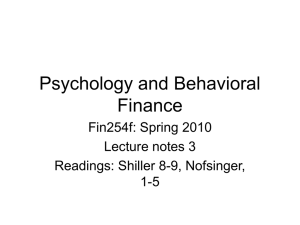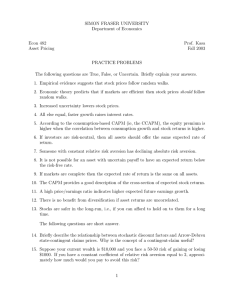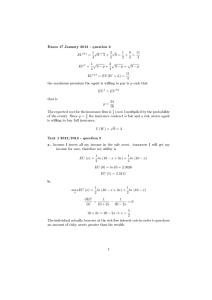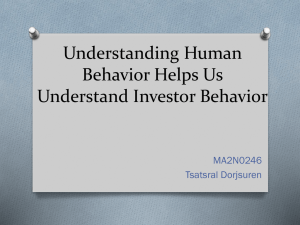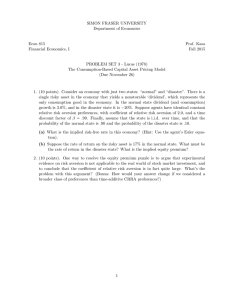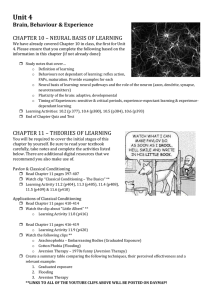Behavioral Finance & Investment Decisions: Asset Impact
advertisement
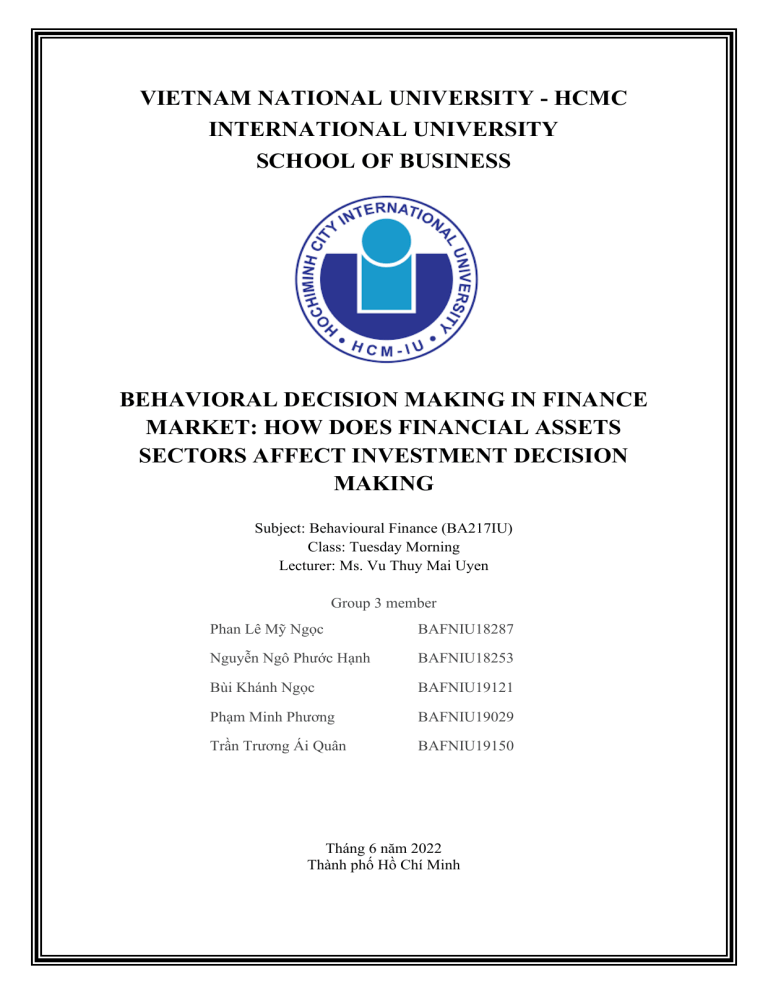
VIETNAM NATIONAL UNIVERSITY - HCMC INTERNATIONAL UNIVERSITY SCHOOL OF BUSINESS BEHAVIORAL DECISION MAKING IN FINANCE MARKET: HOW DOES FINANCIAL ASSETS SECTORS AFFECT INVESTMENT DECISION MAKING Subject: Behavioural Finance (BA217IU) Class: Tuesday Morning Lecturer: Ms. Vu Thuy Mai Uyen Group 3 member Phan Lê Mỹ Ngọc BAFNIU18287 Nguyễn Ngô Phước Hạnh BAFNIU18253 Bùi Khánh Ngọc BAFNIU19121 Phạm Minh Phương BAFNIU19029 Trần Trương Ái Quân BAFNIU19150 Tháng 6 năm 2022 Thành phố Hồ Chí Minh TABLE OF CONTENT I. Introduction ............................................................................................................................ 3 1. Motivations......................................................................................................................... 3 1.1 Research Questions....................................................................................................... 3 1.2 Research Objectives ..................................................................................................... 3 2. Literature Review ............................................................................................................... 3 2.1 The Finance Behavioral and Prospect Theory .............................................................. 3 2.2 Investment Decision-Making ....................................................................................... 4 2.3 Herding Behavior ......................................................................................................... 4 2.4 Overconfidence ............................................................................................................. 4 2.5 Emotional Bias ............................................................................................................. 5 2.6 Loss Aversion ............................................................................................................... 5 2.7 Regret Aversion ............................................................................................................ 5 2.8 Financial Literacy ......................................................................................................... 6 II. Methodology ......................................................................................................................... 7 1. Theoretical framework ....................................................................................................... 7 2. Methodology ...................................................................................................................... 7 III. Results and Discussion ........................................................................................................ 9 1. Result.................................................................................................................................. 9 1.1 DESCRIPTIVE STATISTICS ..................................................................................... 9 1.2 SMART-PLS TEST.................................................................................................... 10 2. Discussions ....................................................................................................................... 12 IV. Conclusion ......................................................................................................................... 14 V. References ........................................................................................................................... 15 2 I. Introduction 1. Motivations This dissertation analyzes the consideration of investors through the reflection of the prospect theory perspective on financial behavior. The goal is to explore the factors that act as a tool for studying various behavioral biases of individual investors. We aim to demonstrate how such models might help behavioral finance research by establishing a relationship between financial considerations and investing decisions. So far, research in the combination of behavioral finance and investment decision making is an important tool to help investors precisely invest their assets. Some of the early studies expressed through the reflection of the prospect theory perspective on financial behavior, have been concluded by some opinions and definitions that behavioral finance is a subsystem of psychology in the economic field (Pompian & Wood, 2006; Kiyilar & Acar, 2013). Therefore, the confluence of behavioral finance and investment decision making encourages us to ask open questions and research opportunities. 1.1 Research Questions The goal of the study was to find out the answers for 2 questions: how investors are affected by a variety of financial assets available in the financial markets, which are divided into three categories: fixed income, equity, and derivatives as well as to detect if there is a relationship between herding and decision-making overconfidence factors. 1.2 Research Objectives This research was conducted to obtain several objectives, and the focus research was based on financial behavior theory and prospect theory as grounded theory, for example, to gain a comprehensive understanding of how investors are affected by various financial assets available in the financial markets in three main types: fixed income, equity, and derivatives. Furthermore, to experimentally examine and validate the relationship between herding and overconfidence variables and levels of loss aversion, regret aversion, and financial literacy while making investment decisions; To focus on the respondents are investors with long experience and younger generations like university students with base knowledge about investment. 2. Literature Review 2.1 The Finance Behavioral and Prospect Theory At first, individuals who make investments employ psychological elements and evaluations of the prospects for investment instruments when making their judgments. The existence of these psychological elements has an impact on investment decisions and outcomes (Xiao, 2008). Behavioral finance, according to Shefrin (2007), is the study of how psychological factors influence financial behavior. Prior to the advent of behavioral finance theory, there was a traditional theory or fundamental economics that linked finance to the economic theory under the assumption that all market participants had the same information. Furthermore, most of the internal factors that lead to irrational behavior are psychological (Sahi et al., 2013), and they serve as the foundation for desires, motivations, and sources of error due to the potential for excessive overconfidence, incorrect perception, illiteracy, and inability to control emotions, particularly negative ones (Michailova & Schmidt, 2016; Meier & De Mello, 2019). The 3 Prospect Theory, on the other hand, was developed by Kahneman (1979) as part of behavioral finance to explain investor behavior. According to Kahneman and Tversky (2013), the analysis of risk-taking decisions dominates the anticipated utility theory as a normative model for rational choice and is frequently used to analyze economic behavior. Furthermore, Kahneman (1979) concentrated on the cognitive and heuristic errors that lead to irrational investment behavior (Kliger & Tsur, 2011). As a result, the prospect theory is based on the idea that people are prone to acting impulsively as a result of their aversion to risking profits in comparison to losses (Cianci, 2008). 2.2 Investment Decision-Making The cognitive aspect is concerned with intellectual capacity and thinking in terms of knowledge, comprehension, application, analysis, and assessment, among other things, whereas the emotional aspect is concerned with ethical conduct, sentiments, attitudes, and emotions, among other things. In behavioral finance, the introduction of psychological biases tends to shift reasonably to illogical behaviors while making financial decisions (Peters, 2003). Emotions and mood impact an investor's biased and often illogical conduct during the financial decision-making process, according to Mittal (2010). Brunsson (2014) believes that uncertainty reflects decision-makers lack of trust in the information provided and poses risks as a result of the difficulty in making decisions. The likelihood of cognitive structure, imprecise judgment, and shift in estimation was also identified to be causes of doubt (Brunsson, 2014). Furthermore, internal variables have a significant role in influencing an investor's willingness to take risks, whether as a risk-taker or a risk avoider, while making investing selections (Kliger & Tsur, 2011; Fong, 2013; He & Choi, 2020; Nguyen, 2020). 2.3 Herding Behavior Herding happens when a group of investors moves in the same direction and at the same time (Nofsinger & Sias, 1999). It's a habit of imitating others' activities rather than relying on personal facts and knowledge (Hirshleifer & Teoh, 2003; Rompotis, 2018). Due to a lack of public information, it is characterized by Land and Rose (2011) as an individual's proclivity to follow others in making the same investment. The data acquired by monitoring other investors who have previously invested in stock is used to correct mistake bias in information-based herding (Venezia et al., 2011; Banerjee, 1992; Bikhchandani et al., 1992). In reputation-based herding, two managers are in a position where the talents of the two managers are unknown to the employer (Venezia et al., 2011; Froot et al., 1992). The main feature of rational herding is that investors receive the same signal and make the same decision to maximize profits, whereas irrational herding involves decisions made in a panic and emotional state as a result of other investors' shares or asset transactions, causing instability if any unexpected error occurs in both the financial and asset markets. The focus of this study was confined to herding behavior when it came to making real-estate investment decisions (Lee & Lee, 2015). 2.4 Overconfidence Overconfidence is described as an overabundance of confidence in one's capacity to persuade investors to view risk as unimportant while making judgments (Deaves et al., 2019; MoralesCamargo et al., 2015). Furthermore, overconfidence causes investors to overestimate their 4 knowledge and underestimate projections because they place a higher value on their talents than they should (Nofsinger, 2017). Another research defines the idea as an individual's inclination to overvalue their knowledge, talents, and information (Bhandari & Deaves, 2006). It's also been observed that uncertainty may lead to overconfidence as a result of making too optimistic judgments (Fischhoff, 2003; Kartini & Setiawan, 2017; Stotz & von Nitzsch, 2005). Overconfidence bias is classified into two types, according to Shefrin (2007), depending on ability and knowledge. As a result, investors can become overconfident as a result of advice from those with greater expertise in the industry, and the pace at which a person becomes overconfident is determined by their level of experience (Gervais & Odean, 2001; Alrabadi et al., 2011). 2.5 Emotional Bias Emotions are an important component of a person's personality that can impact the result of a choice (Ackert et al., 2003). Emotions have an essential role in uncertain situations, according to Hirshleifer (2001), especially when people are scared to take chances (Riff & Yagil, 2016). This demonstrates the importance of psychology - both affective, which deals with emotions, and cognitive, which deals with an individual's intelligence, understanding, and sensitivity - in the process of making any business choice. The Decision Affect Theory confirmed that emotions from certain activities have an impact on decisions (Mellers et al., 1997; Mellers et al., 1999; Guzak, 2015). This may be shown in how a person learns, remembers, thinks, takes risks, receives, or comprehends highly complicated social information that is relevant to decision-making (Bower, 1981; Bless et al., 1996). Loss aversion, regret aversion, and the status quo are just a few of the emotions that influence financial decisions. However, only two of these aversions were studied in this study: loss and regret aversions. 2.6 Loss Aversion Loss aversion is the practice of retaining more stock in the case of a loss rather than selling when profits are available (Kahneman, 1979). It may also be characterized as a person's inclination to be more sensitive when there is a loss than when there is again (Thaler et al., 1997). People who are afraid of losing money are more careful about making investments when there is no profit than when there is a good return (Haigh & List, 2005). It also entails retaining the stock while the market is losing money in the hopes that the price will rise in the future. Individuals with loss aversion are less courageous and more likely to engage in herding behavior when making investment decisions, according to these criteria and reasons (Dräger et al., 2014). The following hypotheses were developed based on the below hypotheses: H1: Loss aversion affects investment decisions H2: Loss aversion through herding as an intervening variable influences investment decisions. 2.7 Regret Aversion This is described as the fear of acting to prevent repeating past mistakes while making investment decisions (Pompian & Wood, 2006; Chorus, 2014; Corzo et al., 2014). This notion arose from investors' desire to prevent the inevitable regrets that come with poor investing selections. It also raises worries among individual and group investors about price swings, which might result in losses in real estate and current financial assets. Furthermore, the key 5 principle behind this notion is to keep underperforming equities and sell them when the market displays a profit. Regret aversion, according to Pompian and Wood (2006), has the propensity to cause investors to become too cautious and under-risk against the market as a result of ongoing losses, which can lead to herding. This phenomenon is the basis for Loomes and Sugden (1982) and Bell (1982)'s regret theory, which is seen as an illogical explanation of decisions in uncertain situations. However, regret aversion was explained using prospect theory for the sake of this study. H3: Regret aversion influences investment decisions. H4: Regret aversion through herding as an intervening variable influences investmentdecisions. 2.8 Financial Literacy Because financial science is dynamic and deeply rooted in everyday behaviors, absolute financial knowledge is essential, particularly when a person is presented with a variety of commercial items. Making the best decision necessitates having sufficient knowledge, information, and awareness of money and other factors. Financial literacy, according to Cole and Fernando (2008), is the capacity to understand, evaluate, manage, and write about the money that impacts a person's life. Only a few people are aware of the significance of this idea on investment diversification and its capacity to explain difficulties with investor behavior, according to Abreu and Mendes (2010). Financial literacy has been found to have an impact on financial decision-making in studies (e.g., Aryeetey, 2004; Kim, 2004; Akims & Jagongo, 2017; Ahunov & van Hove, 2019; Gil, 2015). These, on the other hand, lead to the following hypotheses: H5: Financial literacy affects investment decisions. H6: Financial literacy through herding as an intervening variable influences investmentdecisions. H7: Financial literacy through overconfidence as an intervening variable influences investment decisions. H8: Financial literacy through overconfidence and herding as an intervening variable influences investment decisions. 6 II. Methodology 1. Theoretical framework Loss Aversion Herding Regret Aversion Financial Literacy Financial Decision Overconfidence Bias 2. Methodology This study analyzed data from the respondents who are residents living in Vietnam, those who are students, those who are working and are investors. The sample size is 50 samples. Questionnaires send to the respondents through social networks. The survey question examines the financial behavior can be seen through 23 questions. The 5-point Likert is applied through 5 levels of scale: totally disagree, disagree, neutral, agree, totally agree. The three independent variables used include Loss Aversion (X1) consisting of three questions (X1.1 - X1.3), Regret aversion (X2) consisting of two questions (X2.1 - X2.2), and Financial literacy (X3) consisting of five questions (X3.1 - X3.5). The two intervening variables were used including Overconfidence (X4) which is composed of two questions (X4.1 - X4.2) and Herding (X5) consisting of five questions (X5.1 - X5.5). The dependent variable was the Investment Decision (Y) with six questions (Y1 - Y6). In addition, the model developed included the moderation and intervening effects of financial literacy and overconfidence variables. The tested for reliability and validity through the use of Cronbach alpha, composite reliability, F-test, R-square, with AVE > 0.60 and outerloading > 0.50 through the application of non-parametric statistical applications Smart-PLS and reviewed using the Consistent PLS-Algorithm section. Moreover, the hypotheses were tested to determine the magnitude of the coefficient of influence and relationship in the consistent bootstrapping sub-section with 50 sub-sample and confidence interval method using the Bias-Corrected and accelerated (BCa) Bootstrap two-tailed at a sig. level of 0.05. 7 8 III. Results and Discussion 1. Result Figure 1. Model Analysis of Smart-PLS 1.1 DESCRIPTIVE STATISTICS The descriptive statistics of the study conducted from data of experienced investors that making day-to-day investment decisions. The sample is quite balanced in terms of genders, a slightly higher in female investors, which covers 66% of the sample size. The investors are young, especially the ungraduated investors (68%) with experience of less than 6 months (62%), which I-FOMO most highly affected due to the lack of expertise and experience. Despite their age and not high income (below 5mil VND accounted for 50%), they are primarily risk-averse investors. Table 1 Sample Demographics (N=50) 9 1.2 SMART-PLS TEST In terms of reliability, Cronbach's Alpha ≥ 0.7 (DeVellis, 2012) and Composite Reliability CR ≥ 0.7 (Bagozzi & Yi, 1988). If evaluate Cronbach's Alpha, there are 4/8 variables that do not 10 match the criterion, according to the data table. Furthermore, 3/8 of the variables in Composite Reliability do not match the criterion. When the unreliable variables are removed, the scale becomes reliable enough to examine the following quantifications. Furthermore, we will use the average variance derived AVE to measure SMARTPLS convergence. Extracted Average Variance (AVE) ≥ 0.5. The AVE index includes 4/8 variables that do not match the criteria, according to the data table, however the remaining number of variables in the scale assures convergence and allows the scale to be used for quantitative analysis afterwards. Moreover, the adjusted R-squared value is smaller than the R-squared value, it's safer to use it to assess the model's fit because it doesn't exaggerate it. The higher the R-squared adjusted index, the more significant the pattern; the lower the R-squared adjusted index, the less relevant the model. The model is good when R squared is adjusted from 0.5 to 1; the model is bad when R squared is less than 0.5. According to the data sheet, the majority of the data table's corrected R-squared values are less than 0.5, suggesting that the model is insufficient and needs to be improved. However, if the regression results you analyzed have R-squared adjusted below 50% (0.5), the results are still acceptable. This is the scale of f Square f Square < 0.02: the effect is extremely small or has no effect. 0.02 ≤ f Square < 0.15: small impact. 0.15 ≤ f Square < 0.35: medium impact. f Square ≥ 0.35: high impact. As a result, Herding has a negligible impact on Overconfidence. It has little impact on Regret aversion, Loss aversion, and financial literacy. Overconfidence, Mod_Financial literacy, and Loss aversion are unaffected by Investment decisions. Investment decisions have a little impact on Herding and Regret aversion. Financial literacy is affected by Investment decisions by 0.235. Finally, with a score of 0.537, Overconfidence has a significant impact on financial literacy. 11 The smaller the p-value (p-value < 0.05), the more likely the null hypothesis should be rejected, and the alternative hypothesis should be accepted. The weaker the evidence for rejecting the null hypothesis and the inconclusive test, the higher the p-value (p-value > 0.05). Therefore, only financial literacy → Investment decisions is supported because p-value < 0.05. => Because most of the respondents are students, they are unafraid of losing money while investing. Consequently, based on the table of Hypothesis test results, each Hypothesis: "Investment decisions are generated from financial information." has been shown valid. All of the other possibilities have been disproven. 2. Discussions According to the findings, a person with increased loss aversion is not really affected to make financial decisions and is usually risk-averse. This is opposite with Kahneman and Tversky (1979) and Kahneman (1979a) observed that a person in a losing position will hold the shares until the business has enough profit. Besides that, despite the fact that the respondents to this research survey were mostly university students with less prior experience auctioning assets such as houses, cars, factories, warehouses, and other assets requiring significant funds. Additionally, items purchased at bidding would be resold as soon as feasible if the market price goes down. Through the use of herding variables as the mediator, it was not determined that loss aversion had a detrimental impact on decision making and this cannot confirm clearly the initial hypothesis. However, the route analysis revealed a positive relationship between loss aversion and herding, implying that investors with high loss aversion are more likely to herd. Moreover, some respondents prefer to rely on the information, advice, knowledge, and actions of others when making investment decisions in order to share the blame for losses and avoid feelings of regret. The mean sample, on the other hand, demonstrated that investors with high loss aversion and a proclivity to herding are not very dominant because they are suspicious of information, advice, and actions not gained from others. This indicates that despite their tendency to make decisions based on the advice of the others, they are more mindful during the process. Furthermore, because of various major aspects associated with investment, such as the considerable amounts necessary, ownership legality, bureaucracy, and whether or not the assets may be resold, investors with loss aversion do not always herd. Due to loss aversion, investors are not really fearful and cautious after winning the auction. Additionally, the level of courage is determined not only by external circumstances, but also by internal ones, particularly from the affective side, such as emotions. This is in line with the findings of Ackert et al. (2003), who found that emotions, whether bad or good, play an important role in decision-making. On the other hand, if an investor's loss aversion is small, they seem to establish investing decisions on information and recommendations from others but not significant approval in this research. This explains that a lower level of loss aversion just might lead to a higher chance of 12 herding behavior and a high level of bravery while making investing decisions. Furthermore, an investor with a low rate of loss aversion is not to feel regret after a loss, and thus favours herding at all. The reflects the increasing loss aversion by being extra cautious in a loss circumstance, which has drifted a bit compared with Haigh & List's (2005) results that real asset auction investors voluntarily acquire tangible assets with a high risk. These behaviors, both at the bidding and during the resale, are based on Kahneman's prospect theory (1979). It's worth noting that this study's conclusions on the association among loss aversion and herding differ from those of previous studies like Haigh and List (2005). Nevertheless, as influencing factors, the overall effect of herding strengthens the negative relationship between loss aversion and investment decisions, as expected. The behaviors generated by the influence of an individual's emotions are known as aversion withdrawal. According to studies by Ackert et al. (2003) and Pompian (2006.) confirming the effect of emotions on personal decisions, whether good or bad, regret aversion was caused by sentiments of fear of taking activities in order to escape regret. These may be related to an intense fear of large financial and non-financial losses, and other decision criteria such as the completeness of the needed paperwork, regional administration, and the nature of the assets gained. The findings (Cole & Fernando, 2008; Vitt, 2005; Shefrin, 2007) that a higher level of financial literacy resulted to the capacity to utilize more information and make individual decisions are in contrast to the findings (Cole & Fernando, 2008; Vitt, 2005; Shefrin, 2007) that a higher level of financial literacy led to the ability to process more information and make personal choices. It also opposites earlier research because the respondents in this study were presented with useful information that necessitated thorough analysis before making an investment decision. In contract with this reasearch, Gervais and Odean (2001) and Alrabadi et al. (2001) reinforce the notion that financial literacy has no effect on overconfidence (2011). 13 IV. Conclusion In comparison to the original report, our searches found completely opposite results. The reason for this is that the respondents in the original paper are real asset investors with experience in auctioning assets such as houses, cars, and factories, and they have a lot of investing experience. While our respondents are primarily university students and young adults with little or no experience in investing. Furthermore, our research focuses on individuals who invest in three types of assets: fixed income, equity, and derivatives. This explains why our study found such a high risk-taking rate, because these three groups have a lower value than real assets. Our biggest limitation is our small sample size, which increases the likelihood of accepting a false premise as true. Our recommendation is to sample a larger portion of the population, keep our survey open, and collect more responses. 14 V. References “The Financial Behavior of Investment Decision Making Between Real and Financial Assets Sectors.” Korea Science, 8 November 2020, <https://www.koreascience.or.kr/article/JAKO202034651879374.pdf> 15
